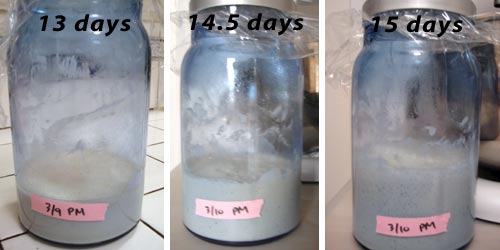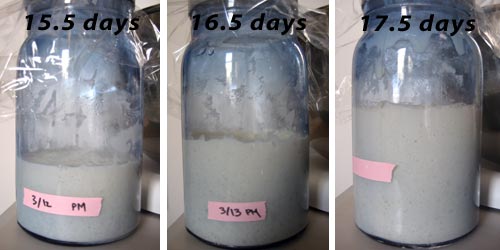Sorry it’s taken me so long to finish the Sourdough Starter saga, but I’ve been busy with various grad school matters, including preparing for a thesis committee meeting. Don’t worry, I’ll spare you the details of that and get right to what really matters. And that would be my lovely starter.
In Part 2, we left off at 10.5 days. I had missed the feeding at 10 days due to getting home too late from Nathan’s thesis talk celebration and figured I would wait until the morning (10.5 days) to feed it. The next morning, we were scheduled to leave for an overnight camping/barrel-tasting trip, so I quickly fed the starter and took off for sunny wine country.
When I got back the next night (12 days), though, nothing had happened. No rise, no foaminess, nothing! I didn’t even take a picture of it because it literally looked exactly like the picture at 10.5 days. Did I kill it? Is it mad at me for being lazy and negligent? Am I a terrible starter mom? Instead of throwing everything out and restarting from scratch, though, all the books and internet forums I read said to just keep on feeding the starter and see if it comes back. There were claims that “most of them do”, which I found skeptical, but I gave it a try anyway. So I fed the starter with the same recipe (½ cup warm water, ⅔ cup bread flour, ¼ starter) that night (12 days).

The next night (13 days), there was still no rise or bubbliness. I fed it again and decided to give it a couple more days. Reasoning that I should let more yeast accumulate, I didn’t feed it the next night (14 days). Lo and behold, the next morning (14.5 days), the starter has risen a little! Is it coming back to life??
Coming home from work (15 days), even more bubbliness and foaminess greeted me and I decided to no longer be so skeptical about the internet, at least as far as bread-baking is concerned. I fed it that night (15 days) and went to bed.

Check out the doubling in a mere 8 hours, at 15.5 days! From what I’ve read, if a starter is able to double or triple its volume and fall back within a 24 hour period, then it’s ready to be used. And it was looking like my starter is almost at that stage! That night (16 days), I fed it again and the next morning (16.5 days), it was able to rise even higher than the previous day, almost tripling its own volume. Awesome!!
The final step before using the starter in a bread recipe is to scale up because you usually need more than a cup of starter to make bread with. So that night (17 days), I did a bigger feeding – ¼ cup starter, 1 cup water, 1⅓ cup bread flour. The next morning (17.5 days), the starter doubled its volume and it was all ready to help me rise some bread!
I used 1½ cup starter to make bread (to come in another post) and saved ¼ cup to keep the starter going. Since I don’t plan on baking every day or even every week, I used the same recipe as for a feeding, mixed everything in a glass jar, loosely covered with plastic wrap and stuck the whole thing in the fridge. Supposedly, once in the fridge, you should only have to feed the starter once a month or so, although obviously, the more often you use it, the more “vigorous” it will be.
In my case, I kept mine in the fridge for 2 weeks without touching it before deciding to bake more bread. I took it out of the fridge, fed it with the normal recipe, and left it at room temperature for 24 hours. If the starter is able to double or triple its own volume and fall back within that period, then it’s ready to be scaled up for bread. If not, feed again and wait another day.








